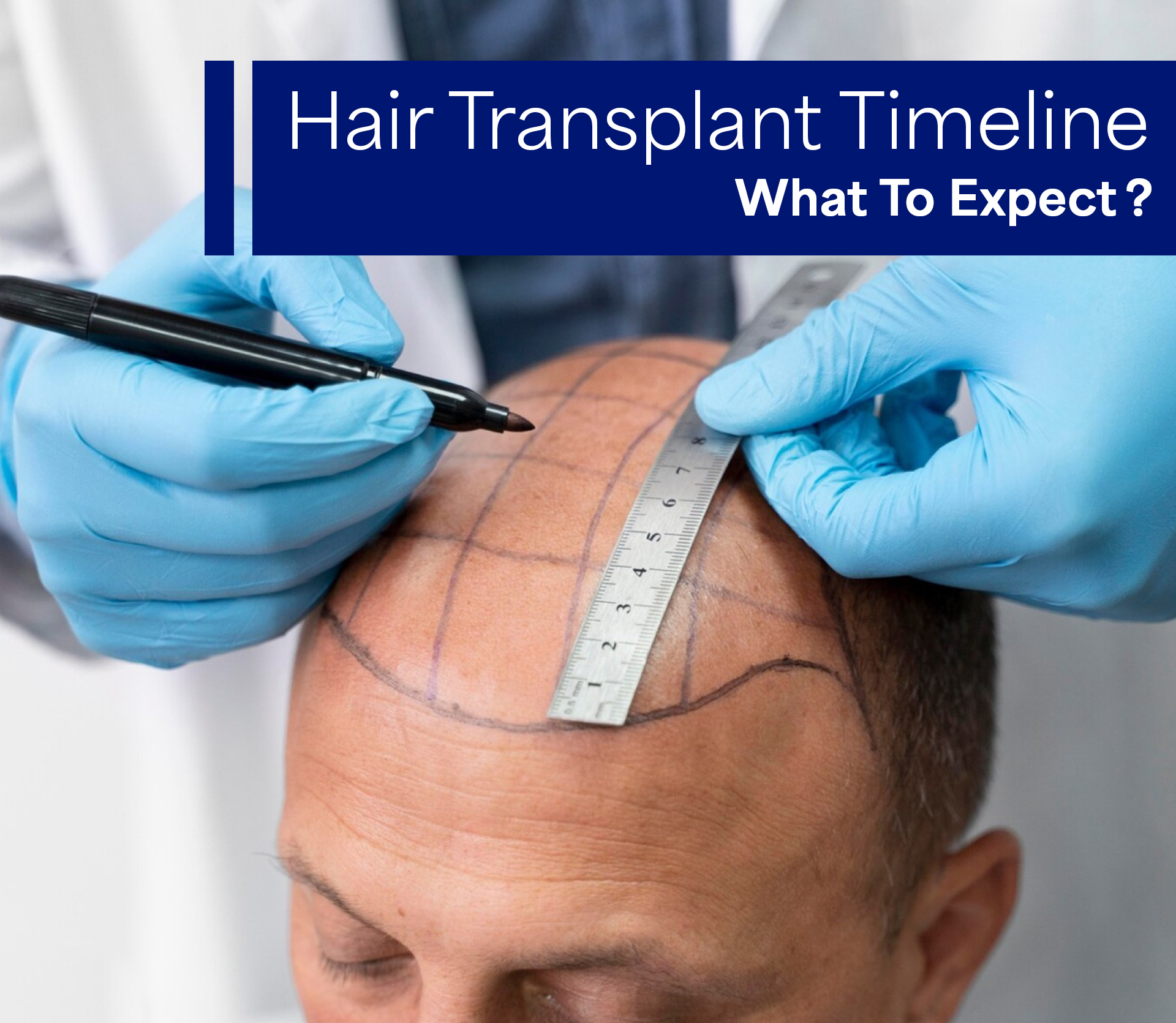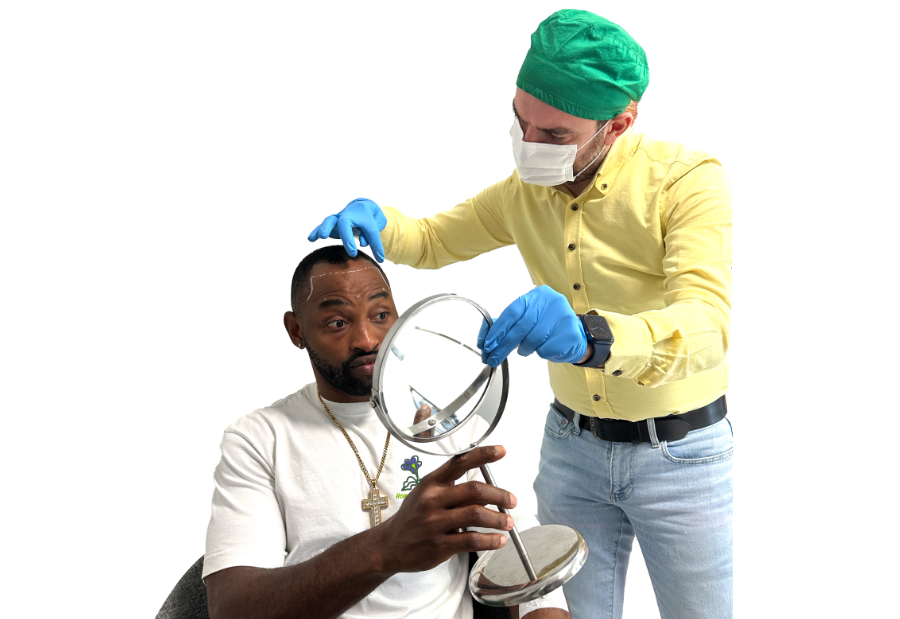Get 25% OFF Hair Transplant Packages This New Year — Book Today!
Hair Transplant Timeline: What To Expect

When you undergo a hair transplant, it can just be a solution for restoring hair. But, that is not the online solution. Instead of perceiving it as a permanent solution, it takes a year’s time for hair to grow.
Subsequent to the medical procedure, you also have to follow tips for aftercare. You must also follow some guidelines for complete recovery.
So, in this article, we shall cover more about the hair transplant phases. Moreover, as you continue reading ahead, you will know what you will expect soon.
What are the different stages of hair growth?
Before we proceed with the timeline, you must understand the hair growth stages. These include Anagen, Catagen, Telogen, and Exogen.
Anagen
- Anagen is nothing but an active phase of hair growth. Under this phase, the hair cells divide and multiply in hair follicles.
- These also push the hair shaft up and out of the scalp. While the duration of this phase varies, it can last for 2 to 3 years.
- It can also be as long as 7 years. If the stage is longer, then the hair will be quite longer.
Catagen
- This is a short phase, and it lasts for around 2 to 3 weeks.
- During this phase, the hair stops growing.
- Moreover, the hair follicles also shrink. Later, the hair shaft becomes club hair. This is eventually pushed out of the follicle.
Telogen
- During this phase, you will not observe active hair growth.
- Rather, around 10 to 15% of hair present on your scalp is in the telogen phase.
- Ultimately, hair will shed as new hair starts growing in the anagen phase.
Exogen
- Among the hair transplant phases, this one usually overlaps the telogen phase.
- People also experience hair shedding during this phase.
- But, there’s nothing to get scared about because shedding is normal. As shedding continues, new hair grows in its place.
Now, let’s check the hair transplant timeline month by month.
7 Days after Hair transplant
Soon after the hair transplant, the donor’s and recipient’s areas will start healing. The areas taken into account will also ache. The individuals will also have to bear the itching sensation as scabs start forming and falling off.
But, if you follow some aftercare instructions, then you will be along the path of recovery. Apart from everything else, you should take some medications. These can offer instant relief when you experience discomfort.
You will also not feel the pain while sleeping. On the other hand, it’s advisable to wear a hat and not wash your hair. You also must avoid scratching your scalp.
2 Weeks after Hair Transplant
As the areas continue to heal during the hair transplant phases, the swelling will subside. But, you will experience an itching sensation as scabs fall off naturally. This is completely normal during the recovery phase.
Besides, you will be able to sleep in any position with less discomfort. During these weeks, hair will also start shedding. New hair will, thus, start growing. On the flip side, you can commence daily activities.
Your head can also be soaked under water. This will help to wash away the scabs. But, regardless of the reason, you shouldn’t remove the scabs on your own.
1 month after hair transplant
This is one of the hair transplant phases in which the hair will enter the telogen phase. It will also fall out gradually in the exogen phase.
This is the main reason why the hair sheds after a hair transplant. But, throughout the growth cycle, this part may appear patchy. At the donor’s end, however, you will observe substantial hair growth in the areas.
2 months after hair transplant
In a span of two months, hair will continue to grow. At the same time, you may also observe shedding. But, the pace at which this occurs will vary from individual to individual. In that case, you must be patient. You also don’t have to worry about patchiness in the scalp.
This is because diverse parts of the recipient’s area will be under various phases. This is completely fine, and there’s nothing to worry about.
3 months after hair transplant
During the third month, new hair will start emerging. These are quite thin and transparent. But, even then, you have to be patient as the hair gradually grows.
You shouldn’t panic as new hair appears. As time passes, the volume of hair will be quite more. Hair will also be thicker than it was earlier.
4 months after hair transplant
By the fourth month, you will observe more hair growth. Initially, hair will grow in patches before it becomes uniform. But, if you want to learn more, then check out some blogs online.
Hair transplant: 6 months
Now, you will be happy to know that you have surpassed the ‘ugly duckling stage.’. This is one of the hair transplant phases in which hair grows and sheds often. This means that the recovery phase has entered a phase where new hair is growing.
However, the hair hasn’t completely matured as yet. A growth spurt will then be observed from the new hair. As this continues for a few months, hair will become thicker. The hair transplant technique, in such cases, can affect the growth rates.
Hair transplant 9-12 months
As you observe hair growing for around 1 to 2 cm every month, it will continue to be thicker. In that case, you can get the haircut depending on your style. This is possible because the hair has now grown to a good length.
Hair transplant 12-18 months
Now, between the period from 1 year to 18 months, you can observe the final results. Every hair strand will be completely penetrated in the scalp. You will also reclaim your confidence with thick and dark hair.
Finally, if you wish to restore a natural look across the hair transplant phases, then it’s essential to follow an aftercare routine. This will help the hair to grow at an optimal level. Way ahead, you must also not scratch the transplanted area.
This can lead to an unbearable irritating sensation. Using harsh chemicals must also be avoided while washing your hair. A healthy diet rich in vitamin D, biotin, and zinc can further support hair growth. When you’re stepping outside your house, you must also wear a hat. This will protect the scalp against intense sunlight.
Book a Consultation
If you have lost your confidence due to hair loss, then why not approach Grace Touch Clinic? As we will restore your look, our surgeons will embrace modern techniques.
An artistic vision along with precision will also ensure incredible results.

